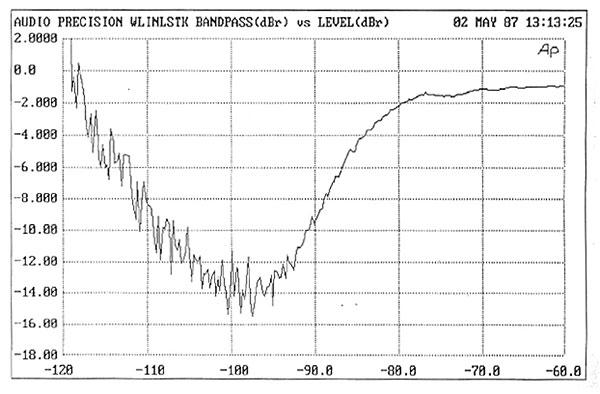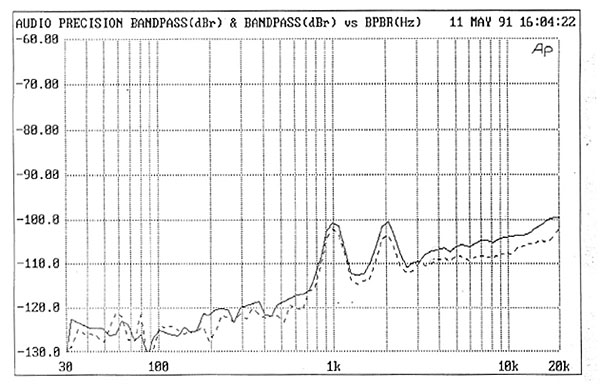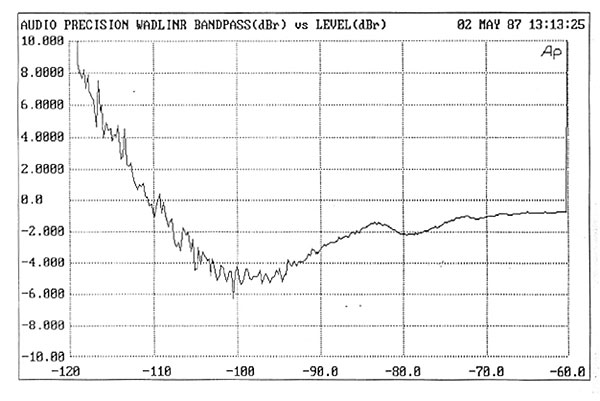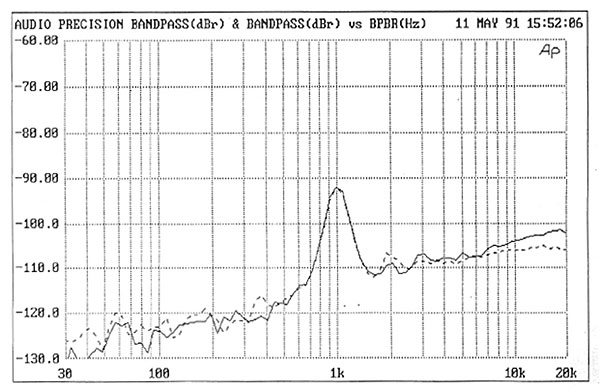| Columns Retired Columns & Blogs |
Wadia Digimaster 2000 Mk.2 digital processors October 1992
Follow-Up from October 1992 (Vol.14 No.10):
Footnote 1: I was very impressed by this little 60W amplifier (reviewed by TJN in April 1996).
In my report on the Wadia Digimaster 2000 in the June issue, I reported on the latest version of this sophisticated processor's sonic and technical attributes. I found the 2000's musical presentation extraordinary—unequivocally Class A performance in Stereophile's "Recommended Components." My measurements, however, revealed some odd behavior: the low-level linearity was very poor—among the worst I'd ever measured—and the unit decoded a –90dB, 1kHz signal at –100dB and generated a spurious 2kHz signal nearly equal in amplitude to the test signal. The 2000's deviation from linearity is shown in fig.1. The "curve" should ideally be a straight line—no error. Fig.2 is a spectrum analysis of the 2000's output when decoding a –90.31dB, 1kHz sinewave, showing the spurious 2kHz component.

Fig.1 Standard Wadia 2000, left-channel departure from linearity, 16-bit data (2dB/vertical div.).

Fig.2 Standard Wadia 2000, 1/3-octave spectrum with noise and spuriae of dithered 1kHz tone at –90dBFS with 16-bit data (right channel dashed).
The combination of poor low-level linearity and the creation of a new signal exactly double the frequency of the test signal led me to conclude that both problems were caused by non-linearity and non-monotonicity in the 2000's D/A converters. The 2000 uses four DACs per channel, with a single MSB trimmer for all four chips. I discussed the measurements with JA and two other people, one an expert in DAC design, the other an expert in D/A converter measurements. All agreed with my fundamental conclusion: DAC non-linearity was the cause of the poor measurements. See pp.214–215 of the June issue for a full technical discussion of the 2000's behavior.
Wadia Digital, however, disputed my findings. They contended that the DACs were perfectly aligned and that the unusual measurements were a result of one particular instruction in the ROM (Read-Only Memory) chips. Eight ROMs inside the 2000 contain the list of instructions that tell the 2000's four DSP (Digital Signal Processing) chips how to process the audio signal. The ROMs are the 2000's brain, the DSPs the muscles.
Consequently, Wadia sent me a new set of ROMs to replace the stock ROMs and indicated that these would produce better measurements. In addition, Wadia showed me a printout of both ROMs' instructions. The only difference was one line of code: one ROM set had the instruction "Dither and truncate," while the other ROM set was instructed to "Dither and round off." Other than that one line, the two sets of software were identical.
I replaced the stock ROMs with the custom chips and repeated the measurements; the results are shown in figs.3 and 4. The linearity is much better (fig.3) and the 2kHz spurious component is nearly gone from the spectral analysis (fig.4). Clearly, the anomalous measurements were not the result of DAC misalignment as I concluded. Wadia knows that the ROMs shipped with the 2000 will produce the non-linearity and spurious component seen in figs.1 and 2, but felt that they are sonically superior to the software that produces the "good" measurements of figs.3 and 4.

Fig.3 Non-standard Wadia 2000, left-channel departure from linearity, 16-bit data (2dB/vertical div.).

Fig.4 Non-standard Wadia 2000, 1/3-octave spectrum with noise and spuriae of dithered 1kHz tone at –90dBFS with 16-bit data (right channel dashed).
This is a quandary. The fact remains that the superbly musical Wadia 2000, as shipped, actually reproduces a 1kHz, –90dB sinewave as a –100dB, 1kHz signal and a –100dB, 2kHz signal. Can this condition actually sound better than a correct reproduction of low-level signals? If so, it raises fundamental questions about digital audio reproduction and the relevance of these measurements. The idea that this distortion of the signal can be preferable to no such distortion is antithetically opposed to my fundamental beliefs about audio systems. Measurements are not the final word in audio equipment quality and cannot replace a good set of ears, but there is something disturbing about the fact that Wadia chooses to ship the unit with the performance seen in figs.1 and 2 when they can ship it with the performance seen in figs.3 and 4.
What really matters, however, is how the two sets of software compare sonically. I auditioned them at matched levels, allowing a warmup after switching chip sets. The playback system was the Wadia WT-3200 transport driving the 2000 through the glass-fiber interface, which fed a Jeff Rowland Design Group Model 1 amplifier (footnote 1) through EVS balanced Ultimate Attenuators. Loudspeakers were Hales System Two Signatures, connected with bi-wired runs of AudioQuest Sterling/Midnight cable.
After spending some time with the stock chip set listening to music and some test signals (the Fade to Noise with Dither on the CBS Test Disc and the bonger tones on the Chesky Test CD), I switched chips. I expected a marginal difference at most—how different could they sound?
The difference was staggering—a word I don't use lightly. In fact, the 2000 went from being an exceptional D/A converter with the stock chips to sounding like a $150 mass-market CD player with the replacement ROMs. The treble became bright, hard, strident, and generally unpleasant. Soundstage depth collapsed, with none of the layering and resolution of hall ambience that characterize the stock 2000. The entire presentation became flat, glaring, and unmusical. Detail was exaggerated; it was like looking at the Mona Lisa in Day-Glo colors.
On Intermezzo (Stereophile STPH003-2), for example, the piano took on a hardness I've never heard from this recording. Through any other converter, the treble is anything but strident. With the replacement ROMs, there was an artificial sterility to the instrument that contrasted sharply with the lush, gorgeous rendering provided by the stock ROMs.
With The English Lute Song (Dorian DOR-90109), the lute became similarly offensive, sounding as if it had been close-miked with a peaky condenser microphone. Julianne Baird's voice was overlaid with a hashy, spitty sibilance that was entirely unnatural. The room shrank to a fraction of its former size, the performers no longer enveloped in the acoustic.
A jazz recording became thin and hard, lacking any sense of low-frequency weight or rhythm.
I could continue, but I'll spare all of us. In short, the chip set Wadia ships with the 2000 was infinitely [!—Ed.] superior musically and sonically to the chip set that produced better measurements. Interestingly, I heard very little difference with the test tones. The Fade to Noise was virtually identical, but the Chesky bonger was overlaid with more fuzz with the replacement ROMs—exactly the opposite one would expect from looking at the measurements. The noise-floor modulation, however, decreased with the replacement ROMs; there was less pumping of the background noise by the bonger tone.
It is ironic and inescapable that someone who designed or evaluated D/A converters strictly by measurement would have judged the replacement ROMs' performance as "better"—another case where measurements are no substitute for critical listening. An unquestioning faith in these measurements coupled with a dismissal of personal listening impressions would not only fail to lead a person toward "goodness," but would spin him around and send him blindly in the opposite direction. This episode reinforces a tenet I hold very strongly: Audio equipment quality is irreducible to an arbitrary set of numbers.
But why should the condition that produces poorer measurements sound so much better? Are we measuring the wrong things? What measurements would reveal the sonic differences between the two sets of software?
Perhaps Wadia can shed some light on this quandary in a "Manufacturer's Comment."—Robert Harley
Footnote 1: I was very impressed by this little 60W amplifier (reviewed by TJN in April 1996).
- Log in or register to post comments




































